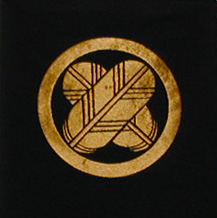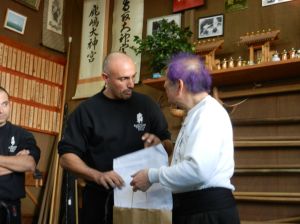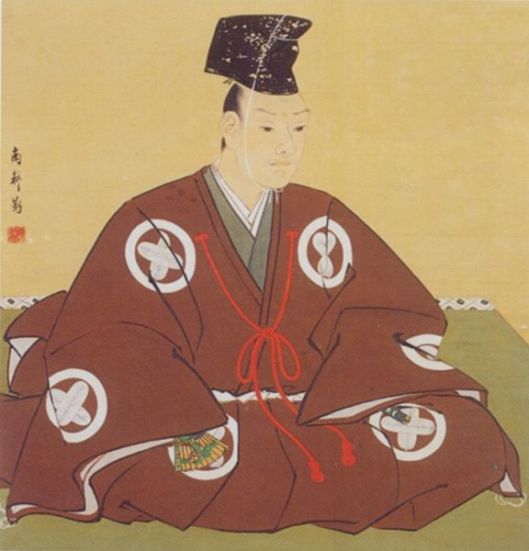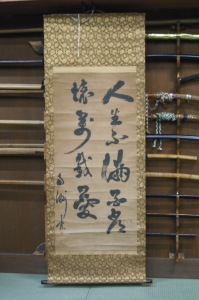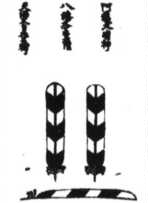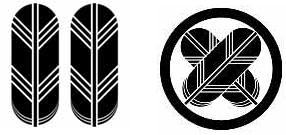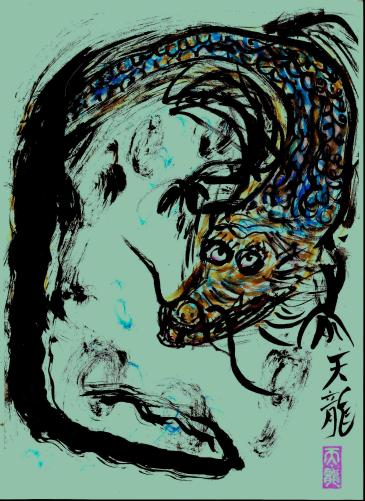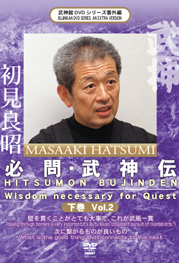From TENRYU by jorgevaccaro
KAMON
家紋
能ある鷹は、爪を隠す
“The virtuous hawk hides it’s nails”
Japanese Proberv.
During our trip to Japan on abril 2012, I brought Soke a present in gold painted wood, that I made off his “Kamon”
The Kamon is the japanese simbol highlighting the badges of the diverse clans that existed during the feudal period of Japan.
They correspond to symbols, most of them rounded, with designs of flowers, birds, plants, and nature phenomenons, even arrows, that represent the “trademark” of a family. Those designs are attached to history and philosophy of the ascendants. It is estimated that these days there are over 20.000 kinds of Kamon.
They go back to the Heian Era (794 a 1192) when it was simply used to distinguished the oxen floats from nobelty. Later on, the symbol was used on several family belongings.
Later, on the Kamakura era (1192-1333) the kamon showed up on flags and standarts that samurai used when they fought in mass and where riding horses. In the battlefield using armours and helmets (kabuto), the different emblems served to distinguish their own people. Some Kamon where also used on the chest of the armor or in the helmet. The emblems of war where more simple compared to those at home, because they had to be recognized from afar.
The Kamon 家紋, could also be called with other names like ”Mon 紋 “, ”Monshō 紋章 ” y ”Mondokoro 紋所 “.
The Mon of the family of Sôke Masaaki Hatsumi is designed with two hawk feathers crossed. The name of the Kamon is “Maruni chigai takanoha” 丸に違鷹羽. The hawk is a symbol of the samurai from ancient times.
Image: Over the Kabuto (helmet) of Soke Hatsumi, one can appreciate the Kamon.
“Hawk Feather”, was used as decoration on the moments of thriumph and victories, as also for special ceremonies such as New Years Eve. On some ancient clans became to be one of the most important symbols on battle times.
This Kamon is also used by the family of Shihan Someya Kenichi, of Bujinkan Dojo.
All of the ancestors of the family of Sôke Masaaki Hatsumi, and also Shihan Someya Kenichi, are connected to ancient Samurai linages.
While we appreciated the Kamon, Shihan Someya told me that it’s also a symbol of his own family, he told me the information that the Kamon came from Daimyo Asano, from the Hiroshima area.
So with the investigation on the run about this Kamon, I truly found that there’s an enormeous inflouence at the zone of Hiroshima, that connects to Asano Naganori (浅野長矩 1665 –1701) who was a Daimyo from the Akō Domain, a small feud between Okayama and Himeji, His Daimyo title was Takumi no Kami 内匠頭
Image of Asano Naganori with the Kamon on his Kimono
The Kamon is also registered within the family of the well known Saigō Takamori (西郷 隆盛 1828 -1877) who was a Samurai and Polititian, who lived during the last years of the Edo period and beginnings of the Meiji era. Initially, was one of the polititians who supported the elimination of the Tokugawa shogunato, and backed up the Meiji restoration, afterwards he got involved in the Meiji government. But in 1877, after the sistematic persecution of the samurai by the new government, he was in front of the Satsuma rebelion, that was going to be the last conflict headed by the samurai on Japanese History. To many people, Takamori is considered the true last samurai.
Image: original writing of Saigō Takamori – Soke Hatsumi collection.
There may be an interesting relation, because Sôke during 2011, showed us a caligraphy from the very Saigō Takamori
Three important points of connection:
1. The family of Asano ( 浅野氏 Asano-shi) where samurai names on the feudal times since the family that had control of the “Han” (feude) of Hiroshima, centered in the castle of Hiroshima during great part of the Edo period . The Asano are descendants of the emperor Seiwa (850-880), of Minamoto no Yorimitsu (944-1021), and they’re a branch of the Toki family.
Minamoto no Mitsunobu, descendant of Yorimitsu in the 4th generation, established in Toki (Mino) and took the name of such place. The Toki where hereditary “Hugo” (governors) of the Mino province until the 16th century. The name of Asano maybe the most well known,as a result of the history of the 47 Ronin ( http://es.wikipedia.org/wiki/47_r%C5%8Dnin) , whos lord was Asano Naganori , the leader of a branch of the feudal family in Ako.
2. The Kikuchi clan ( 菊池氏) ( http://en.wikipedia.org/wiki/Kikuchi_clan ) of the province of Higo was a poweful family of Daimyo within the zone of Higo, Kyushu. The Kikuchi linage was known of it’s brave service in defense of the emperor and against foreign invadors. The first clan was distinguished during the Kyushu inversion in 1019.
Image: Different evolution of the symbols of the Hawk feathers, until they became the known Kamon.
The Kikuchi family reached fame during the mongol invasion of Japan on 1281, when the Heroism of Kikuchi Takefusa helped to make the enemy back away.
This clan also had active partitipation during the Kenmu restauration (1333-1336), in the attempt to reaffirm the imperial authority by the emperor Go-Daigo against the Kamakura Shogunato. This also shows a tight relation with the history of the Kukishinden and the history of Kurando Yakushimaru on the rescue of the Godaigo emperor, well known history about the schools of Bujinkan.
3. Another of the odd but not surprising connections with this Kamon, comes from India, from the Handas Clan. The Handas, with other warrior clans as Kshatriya ( http://castesysteminindia.com/), have developed a crucial part in the creation of India/Aria history. Aside of a very rich and prominent past in India, the Handas descendants can now be found in many parts of the world. Many Handa families are living in England, Canada, Japan, Australia, US, etc.
To finish, I’d like to remind everyone that Sôke with his teachings, have made of the Bujinkan a great family. Among the rules of the Shidoshikai of the Bujinkan Dojo, it’s authorized to wear just one Patch or Mon, on the left side (heart) of the Gi. The same is the symbol of the “Bujin” which identifies us as a part of the same family, a same linage.
Let us protect the family, training with enthusiasm and doing battle with the gestures of the heart.
By Christian Petroccello
